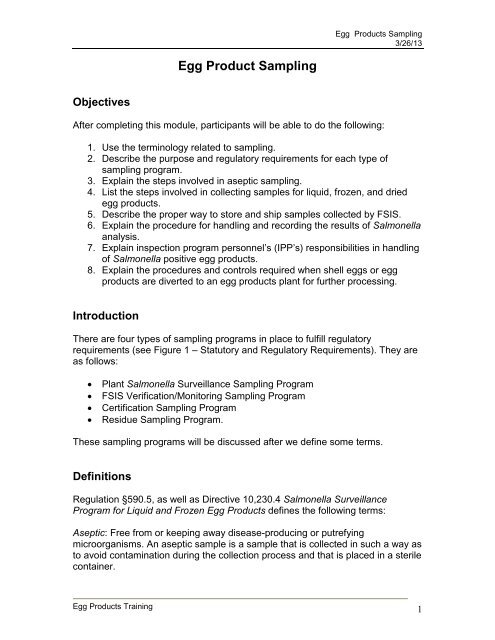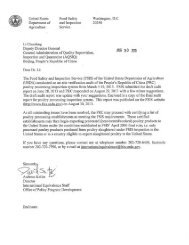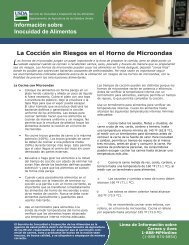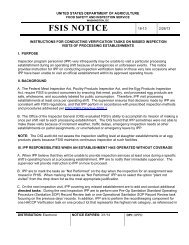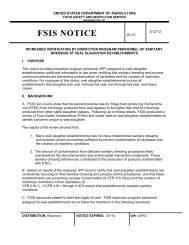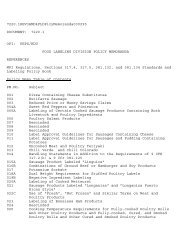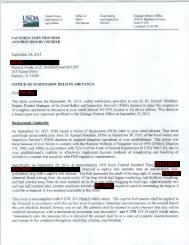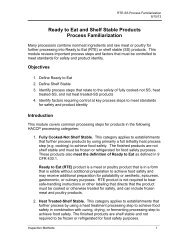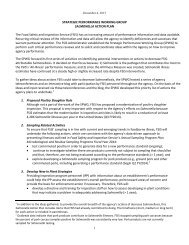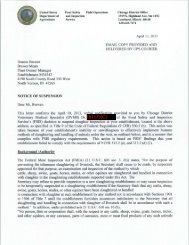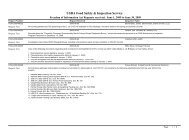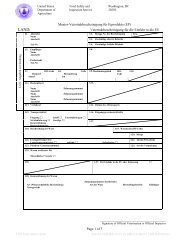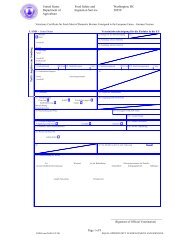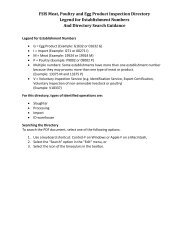Egg Products Sampling - Food Safety and Inspection Service
Egg Products Sampling - Food Safety and Inspection Service
Egg Products Sampling - Food Safety and Inspection Service
You also want an ePaper? Increase the reach of your titles
YUMPU automatically turns print PDFs into web optimized ePapers that Google loves.
<strong>Egg</strong> <strong>Products</strong> <strong>Sampling</strong><br />
3/26/13<br />
<strong>Egg</strong> Product <strong>Sampling</strong><br />
Objectives<br />
After completing this module, participants will be able to do the following:<br />
1. Use the terminology related to sampling.<br />
2. Describe the purpose <strong>and</strong> regulatory requirements for each type of<br />
sampling program.<br />
3. Explain the steps involved in aseptic sampling.<br />
4. List the steps involved in collecting samples for liquid, frozen, <strong>and</strong> dried<br />
egg products.<br />
5. Describe the proper way to store <strong>and</strong> ship samples collected by FSIS.<br />
6. Explain the procedure for h<strong>and</strong>ling <strong>and</strong> recording the results of Salmonella<br />
analysis.<br />
7. Explain inspection program personnel’s (IPP’s) responsibilities in h<strong>and</strong>ling<br />
of Salmonella positive egg products.<br />
8. Explain the procedures <strong>and</strong> controls required when shell eggs or egg<br />
products are diverted to an egg products plant for further processing.<br />
Introduction<br />
There are four types of sampling programs in place to fulfill regulatory<br />
requirements (see Figure 1 – Statutory <strong>and</strong> Regulatory Requirements). They are<br />
as follows:<br />
• Plant Salmonella Surveillance <strong>Sampling</strong> Program<br />
• FSIS Verification/Monitoring <strong>Sampling</strong> Program<br />
• Certification <strong>Sampling</strong> Program<br />
• Residue <strong>Sampling</strong> Program.<br />
These sampling programs will be discussed after we define some terms.<br />
Definitions<br />
Regulation §590.5, as well as Directive 10,230.4 Salmonella Surveillance<br />
Program for Liquid <strong>and</strong> Frozen <strong>Egg</strong> <strong>Products</strong> defines the following terms:<br />
Aseptic: Free from or keeping away disease-producing or putrefying<br />
microorganisms. An aseptic sample is a sample that is collected in such a way as<br />
to avoid contamination during the collection process <strong>and</strong> that is placed in a sterile<br />
container.<br />
<strong>Egg</strong> <strong>Products</strong> Training 1
<strong>Egg</strong> <strong>Products</strong> <strong>Sampling</strong><br />
3/26/13<br />
Production lot: For sampling purposes under the Salmonella Surveillance<br />
Program (Directive 10,230.4), a lot for liquid <strong>and</strong> frozen egg products can be<br />
defined as one day’s production (physically separated pasteurization run) of each<br />
type of product within the applicable category or according to the FSIS<br />
Memor<strong>and</strong>um titled “Definition of a Product Lot” issued on January 17,2001 (see<br />
Figure 2). For dried egg products, the definition of a lot is found on the <strong>Egg</strong><br />
Product Inspector H<strong>and</strong>book (EPIH), Section 8, Part I.A.4-C. Bottom line is that<br />
the plants producing egg products are required to maintain a defined procedure<br />
for the identification of a production lot in their Salmonella Surveillance Program<br />
according to Directive 10,230.4 <strong>and</strong> EPIH.<br />
<strong>Sampling</strong>: The act of taking samples of any product for inspection or analysis<br />
(microbiological, chemical, or physical).<br />
Note: The majority of samples selected <strong>and</strong> analyzed for egg products are done<br />
to determine that the finished product is free of Salmonella .<br />
<strong>Sampling</strong> or product category: Directive 10,230.4 sets forth the sampling<br />
categories for liquid <strong>and</strong> frozen egg product:<br />
• whites (with or without added ingredients)<br />
• whole eggs or yolks (with less than two percent added ingredients<br />
or no added ingredients)<br />
• whole eggs or yolks or blends thereof (with two percent or more<br />
added ingredients other than salt or sugar)<br />
• whole eggs or yolks or blends thereof with two percent or more salt<br />
or sugar added<br />
Sanitize: To apply a bactericidal treatment approved as being effective in<br />
destroying microorganisms, including pathogens.<br />
Types of <strong>Sampling</strong> <strong>and</strong> Testing<br />
The four types of sampling programs conducted in egg products are as follows:<br />
Note: Attachment 5 – <strong>Egg</strong> Product <strong>Sampling</strong> Programs – gives an overview of<br />
the Salmonella Surveillance Program, FSIS Verification <strong>Sampling</strong> Program, <strong>and</strong><br />
Certification <strong>Sampling</strong> Program.<br />
Plant Salmonella Surveillance <strong>Sampling</strong><br />
The regulatory requirement to perform Salmonella sampling is specified in 9 CFR<br />
§590.580 (Figure 1) <strong>and</strong> further described in FSIS Directive 10,230.4. This<br />
sampling program is designed to measure the effectiveness of the plant’s<br />
<strong>Egg</strong> <strong>Products</strong> Training 2
<strong>Egg</strong> <strong>Products</strong> <strong>Sampling</strong><br />
3/26/13<br />
pasteurization process <strong>and</strong> to ensure that post-pasteurization contamination has<br />
not occurred.<br />
Under this sampling program, the plant selects all samples of pasteurized egg<br />
products <strong>and</strong> tests the samples for the presence of Salmonella. All sampling<br />
costs (e.g.; supplies, shipping, <strong>and</strong> analysis) are the responsibility of the plant.<br />
The samples are submitted to a laboratory operating under the “Pasteurized <strong>Egg</strong><br />
<strong>Products</strong> Recognized Laboratory Program” (PEPRLab), which is administered by<br />
the Office of Public Health <strong>and</strong> Science (OPHS) in Athens, GA. For a laboratory<br />
to be eligible to participate in the PEPRLab program they must have at least one<br />
active egg products plant that sends samples to them for Salmonella analysis. If<br />
the plant stops using a lab that was previously approved <strong>and</strong> the lab have no<br />
other egg products plant clients, then that laboratory will be removed from the<br />
PEPRLab list. The process of getting a lab approved takes two to three months.<br />
OPHS maintains the List of Member Laboratories on the FSIS web site at the<br />
following link: http://www.fsis.usda.gov/science/PEPRLab_Program/index.asp.<br />
This list is updated on a regular basis. The web site also provides detailed<br />
information on the PEPRLab program requirements that a laboratory has to meet<br />
<strong>and</strong> information on the application process.<br />
FSIS Directive 10,230.4 (see Appendix 3 – end of the participant’s h<strong>and</strong>out)<br />
provides instructions for the sampling of lots of pasteurized liquid <strong>and</strong> frozen egg<br />
products. The product sampling categories under this program are defined<br />
above. Plants that can demonstrate a history of compliance by producing<br />
Salmonella negative product can follow the reduced sampling frequency<br />
described in the directive once the minimum number of consecutive lots at each<br />
level has been achieved (refer to Attachment 6 – Salmonella Surveillance<br />
<strong>Sampling</strong>). New plants with no history of prior production or plants that introduce<br />
a new product category (new type) must begin sampling all lots of pasteurized<br />
egg products produced for Salmonella <strong>and</strong> determine the lot negative for the<br />
presence of Salmonella. This means that the plant will select samples from every<br />
lot produced based upon the sampling plan in the Directive. As a plant<br />
establishes a history of compliance, they can reduce the frequency of sampling.<br />
The sampling frequency will increase or decrease based on a plant’s history of<br />
producing Salmonella-negative product. Regulation 9 CFR §590.200 requires the<br />
plant to maintain records for each lot of product produced <strong>and</strong> to make the<br />
records available to IPP upon request.<br />
It is also important to note that a plant which produces product in multiple product<br />
categories may have a different sampling level for each of the types of product.<br />
For example, they may be at 1:8 sampling level for whole egg without added<br />
ingredients, 1:4 sampling level for Whole <strong>Egg</strong> with two percent or more salt<br />
added, <strong>and</strong> 100% sampling level for whites. The sampling levels are determined<br />
based on history of compliance <strong>and</strong> length of time the product has been<br />
<strong>Egg</strong> <strong>Products</strong> Training 3
<strong>Egg</strong> <strong>Products</strong> <strong>Sampling</strong><br />
3/26/13<br />
produced, <strong>and</strong> the number of lots of in each category that are produced over<br />
time.<br />
Please note that FSIS Directive 10,230.4 is for lots of liquid <strong>and</strong> frozen egg<br />
products only.<br />
All lots of dried egg products are sampled at 100%, <strong>and</strong> no reduced sampling of<br />
dried egg products is permitted.<br />
• The sampling levels are found in the <strong>Egg</strong> <strong>Products</strong> H<strong>and</strong>book, Section 8,<br />
page 11<br />
• A minimum of 3 samples or 3 composite samples are to be collected from<br />
each lot of product produced from each dryer.<br />
• Each sample or composite sample is to be analyzed individually utilizing<br />
100 gm of product, <strong>and</strong> the results reported individually.<br />
IPP should thoroughly underst<strong>and</strong> the plant’s Salmonella surveillance sampling<br />
program <strong>and</strong> are to verify that the program complies with FSIS Directive<br />
10,230.4.<br />
IPP’s responsibilities are:<br />
• To periodically examine the plant’s records to make certain that the proper<br />
sampling procedures are being followed. The frequency at which IPP<br />
perform these checks will range from daily to weekly, depending upon the<br />
number of lots of product produced by the plant. A check mark or Y for<br />
Yes or N for No should be placed under item #19 on FSIS Form 5400-12<br />
when reviewing the laboratory reports to ensure that each sample<br />
submitted to the laboratory was analyzed individually <strong>and</strong> that the results<br />
have been reported separately (i.e., samples were not composited <strong>and</strong><br />
only one analysis was done).<br />
• To ensure that the plant takes the required actions when a sample is<br />
found to be Salmonella positive<br />
• To initiate appropriate action if there is evidence of noncompliance with<br />
the regulations<br />
• To document non-compliance (according to Directive 5050.1)<br />
FSIS Verification/Monitoring <strong>Sampling</strong> Program<br />
The Agency’s verification/monitoring OPHS-directed sampling programs are<br />
addressed in Directive 10,210.1, Amendment 6, Unified <strong>Sampling</strong> Form.<br />
Currently, processed egg products are broken into seven “Salmonella in<br />
<strong>Egg</strong> <strong>Products</strong> Training 4
<strong>Egg</strong> <strong>Products</strong> <strong>Sampling</strong><br />
3/26/13<br />
Pasteurized <strong>Egg</strong> Product” projects, four of these categories are for liquid egg<br />
products <strong>and</strong> three projects are for dried egg products. The information included<br />
in the microbiological product sampling projects is as follows:<br />
• a project number <strong>and</strong> a project title with the appropriate information<br />
including types of products to sample,<br />
• collection instructions<br />
• a sample request form (FSIS Form 10,210-3; see Figure 3),<br />
• plant management notification<br />
• shipping instructions<br />
Following is a brief description of each project number (name <strong>and</strong> egg product to<br />
sample; see Figure 4).<br />
• EM31, Salmonella in Pasteurized Liquid, Frozen, or Dried <strong>Egg</strong> <strong>Products</strong>:<br />
the product to sample includes liquid <strong>and</strong> frozen egg whites with or without<br />
added ingredients.<br />
• EM32, Salmonella in Pasteurized Liquid, Frozen, or Dried <strong>Egg</strong> <strong>Products</strong>:<br />
the product to sample includes plain liquid <strong>and</strong> frozen whole eggs or yolks,<br />
<strong>and</strong> liquid <strong>and</strong> frozen whole eggs or yolks with less than two percent<br />
added ingredients other than salt or sugar, respectively.<br />
• EM33, Salmonella in Pasteurized Liquid, Frozen, or Dried <strong>Egg</strong> <strong>Products</strong>:<br />
the product to sample includes liquid <strong>and</strong> frozen whole eggs with added<br />
yolks, or whole egg blends (with more than two percent added ingredients<br />
other than salt or sugar).<br />
• EM34, Salmonella in Pasteurized Liquid, Frozen, or Dried <strong>Egg</strong> <strong>Products</strong>:<br />
the product to sample includes liquid <strong>and</strong> frozen whole eggs or yolks with<br />
more than two percent salt or sugar added, respectively.<br />
• EM35, Salmonella in Pasteurized Liquid, Frozen, or Dried <strong>Egg</strong> <strong>Products</strong>:<br />
the product to sample is dried yellow egg products.<br />
• EM36, Salmonella in Pasteurized Liquid, Frozen, or Dried <strong>Egg</strong> <strong>Products</strong>:<br />
The product to sample is spray-dried egg whites with or without added<br />
ingredients.<br />
• EM37 Salmonella in Pasteurized Liquid, Frozen, or Dried <strong>Egg</strong> <strong>Products</strong>:<br />
the product to sample is pan-dried egg whites without added ingredients.<br />
<strong>Egg</strong> <strong>Products</strong> Training 5
<strong>Egg</strong> <strong>Products</strong> <strong>Sampling</strong><br />
3/26/13<br />
FSIS inspection program personnel aseptically collect egg products sample(s)<br />
(directed samples) from each plant that produces egg products. The egg product<br />
to be collected per process is indicated in the sample request. FSIS Field <strong>Service</strong><br />
Laboratories analyzes the sample(s) for the presence of Salmonella. An egg<br />
products plant could be sampled up to seven times per month, depending on the<br />
number of production processes (projects) occurring during the month. For<br />
example, if a plant only produces pasteurized whole egg, then they will only<br />
receive (on average) one directed sample request per month. If they produce<br />
whole eggs <strong>and</strong> egg whites (two separate categories) they would receive two<br />
directed sample requests per month (one for each category of product).<br />
FSIS inspection personnel also need to determine what sampling categories the<br />
plant is producing <strong>and</strong> determine if they are receiving a sampling request for<br />
each category in which the plant produces a product. For example, if the plant<br />
produces product in three of the liquid product categories, but only receives<br />
requests in two of these categories, the IPP need to inform their supervisor <strong>and</strong><br />
PDD of this discrepancy. IPP should receive one sampling request, per month,<br />
for each category of product the plant routinely produces.<br />
Conversely, if IPP are receiving sampling requests for product that is only<br />
producing seasonally, once a year, or they no longer produce the product, IPP<br />
need to forward this information to their supervisor <strong>and</strong> PDD as well so that the<br />
database can be updated to reflect the current list of egg products that need to<br />
be sampled.<br />
If IPP have received sampling boxes which are not needed, they are to send an<br />
e-mail to the Laboratory <strong>Sampling</strong> Outlook Mailbox <strong>and</strong> request instructions <strong>and</strong><br />
mailing labels so that the boxes <strong>and</strong> sampling supplies can be returned.<br />
Certification <strong>Sampling</strong> Program<br />
Certification sampling is performed when the official egg products plant<br />
specifically requests a lot of product to be certified by FSIS. An official plant<br />
may request FSIS certification of lots of egg products to meet requests from a<br />
broker, wholesaler, exporter, or to meet specific contract specifications, military<br />
shipments, or manufacture of school lunch commodity egg products. This type of<br />
sampling is done on a fee for service basis. All costs associated with the<br />
sampling <strong>and</strong> analyses are charged to the official egg products plant requesting<br />
certification, including the cost of shipping containers, sampling materials, <strong>and</strong><br />
shipping fees. The plant is responsible for procuring all of the needed sampling<br />
supplies. <strong>Inspection</strong> personnel are not to use sampling supplies received for the<br />
FSIS Monitoring samples for samples of this type. Certification involves<br />
determining compliance with the specific requirements in a purchase contract,<br />
then issuing a contract acceptance certificate verifying compliance. These<br />
certification-type examinations include:<br />
<strong>Egg</strong> <strong>Products</strong> Training 6
<strong>Egg</strong> <strong>Products</strong> <strong>Sampling</strong><br />
3/26/13<br />
• sampling of egg products for official analysis<br />
• certification by USDA of the bacteriological, chemical, <strong>and</strong> physical<br />
characteristics of a specific lot<br />
• additional requirements may also need to be verified by IPP (e.g., labeling,<br />
solids content, source of breaking stock)<br />
FSIS IPP is to observe a designated <strong>and</strong> trained plant employee collect the<br />
sample from the specific lot(s). The sample is maintained under FSIS control<br />
until it is ready to be shipped. At the time the sample is to be shipped, the IPP<br />
will complete Form PY-200 (<strong>Egg</strong> <strong>Products</strong> <strong>Inspection</strong> <strong>and</strong> Grading Certificate -<br />
see Figure 5) <strong>and</strong> include the PY-200 in the sample collection box when it is<br />
shipped to the USDA, AMS laboratory in Gastonia, NC for analysis.<br />
Certification samples are only sent to this USDA, AMS laboratory, as FSIS<br />
laboratories do not have the ability to bill the plant for the analysis. The USDA,<br />
AMS laboratory reports the results of the analysis back to the Inspector on their<br />
official laboratory report form. A copy of the PY-200 form will also be returned to<br />
the inspector at the origin plant. When egg product is analyzed for the presence<br />
of Salmonella, this type of certification may be substituted for a surveillance<br />
sample if five samples have been selected <strong>and</strong> analyzed individually.<br />
Residue <strong>Sampling</strong> Program<br />
FSIS will collect samples of unpasteurized egg products at official egg product<br />
plants to analyze at FSIS laboratories for chemical residues of veterinary drugs<br />
(including sulfonamides), pesticides, <strong>and</strong> environmental contaminants (such as<br />
arsenics). Unpasteurized egg products samples (generally yellow products)<br />
without added ingredients will be sampled whenever possible. According to FSIS<br />
Directive 10,210.1 the specimen can be either unpasteurized filtered plain whole<br />
egg or yolk as well as pasteurized dried plain whole egg or yolk. Dried samples<br />
should only be submitted if there is no other alternative. A violation in a<br />
production class (food animal or egg product) occurs when a chemical residue is<br />
detected <strong>and</strong> the residue is in excess of an established tolerance or action level.<br />
The Office of Public Health <strong>and</strong> Science (OPHS) reviews their programs annually<br />
<strong>and</strong> in concert with the Agency needs determines the level of residue sampling<br />
that will take place in each egg product sampling category. The Agency will<br />
determine, per their risk assessments <strong>and</strong> other means, what type of testing is<br />
needed. The Agency does not have a policy of notifying IPP of these changes.<br />
Consequently, the frequency of when a residue sample is requested may vary<br />
from year to year.<br />
The collection of samples is directed <strong>and</strong> will be scheduled from FSIS<br />
Headquarters (scheduled sampling). The Residue <strong>Sampling</strong> Program was held<br />
in abeyance for several years, but in March 2010 the project was reactivated by<br />
<strong>Egg</strong> <strong>Products</strong> Training 7
<strong>Egg</strong> <strong>Products</strong> <strong>Sampling</strong><br />
3/26/13<br />
OPHS <strong>and</strong> a new project code was assign to egg products. The residue testing<br />
for egg products is now under the Project Code RM10B regardless of the egg<br />
product specimen collected <strong>and</strong> submitted for analysis. At the present time, egg<br />
product samples are only being tested for one compound, which are<br />
sulfonamides.<br />
IPP will be collecting <strong>and</strong> submitting these samples per instructions in FSIS<br />
Directive 10,210.1. If IPP have questions about a sampling request that was<br />
received or the sampling program, they are to submit their question through<br />
askFSIS. The response received will be from the subject matter expert from that<br />
program area.<br />
Other <strong>Sampling</strong> Programs<br />
Listeria monocytogenes in egg products with shelf life claims<br />
In egg products plants approved to use a shelf life claim on containers of liquid<br />
egg products, the plant most comply with the provisions outline in the document<br />
titled “Notice to the <strong>Egg</strong> <strong>Products</strong> Industry” dated on October 31, 1995 (refer to<br />
Attachment 7). Basically, the egg products industry needs to demonstrate that<br />
the process used for each type of product to be identified with a shelf life claim is<br />
negative for Salmonella <strong>and</strong> Listeria monocytogenes (Lm) immediately after<br />
packing <strong>and</strong> negative for Lm at the end of the claimed shelf life. The firm will<br />
maintain records reflecting the product’s wholesomeness, processing (sanitation,<br />
equipment, procedures, pasteurization treatment, <strong>and</strong> cooling), packaging <strong>and</strong><br />
sample analysis of each production lot identified with a shelf life claim. These<br />
records must be available for review by the IPP.<br />
The Agency will be sampling egg products identified with a shelf life claim once<br />
each quarter. The IPP will pull inspector generated samples as instructed in two<br />
memor<strong>and</strong>a dated November 1 <strong>and</strong> November 16, 1995 (“Use of Shelf Life<br />
Claims in Liquid <strong>Egg</strong> <strong>Products</strong>” <strong>and</strong> “Use of Shelf Life Claims in Liquid <strong>Egg</strong><br />
<strong>Products</strong> – Corrections to my November 1 Memor<strong>and</strong>um”, respectively) (refer to<br />
Attachments 8 <strong>and</strong> 9). IPP will submit to the FSIS laboratory two sample for the<br />
same production lot immediately after packing, using FSIS Form 10,000-2,<br />
Domestic Laboratory Report, requesting analysis for Lm only. IPP should<br />
carefully follow the specific instructions delineated in the memor<strong>and</strong>um dated<br />
November 16, 1995. In addition, before collecting the aforementioned samples,<br />
IPP should request the FSIS Form 10,000-2 <strong>and</strong> sampling materials to the<br />
Supply Center.<br />
As per the memor<strong>and</strong>um dated November 1, 1995, IPP are to review the plant’s<br />
records to assure compliance with provision 2 <strong>and</strong> 3 of the “Notice to the <strong>Egg</strong><br />
Industry”. In addition, IPP should organoleptically examine one of the company’s<br />
samples at the end of the claimed shelf life following the instructions described in<br />
the memor<strong>and</strong>um.<br />
<strong>Egg</strong> <strong>Products</strong> Training 8
<strong>Egg</strong> <strong>Products</strong> <strong>Sampling</strong><br />
3/26/13<br />
Other sampling programs<br />
IPP should be aware of other types of sampling programs that the Agency deems<br />
necessary. For example, these programs can be due to a food borne illness<br />
outbreak or because FSIS is conducting a nationwide raw liquid egg<br />
microbiological baseline survey. In such cases IPP will be instructed how to<br />
proceed.<br />
Submitting AskFSIS Questions<br />
When submitting a question via askFSIS regarding sampling, use the Submit a<br />
Question tab, <strong>and</strong> enter the following information in the fields provided:<br />
Subject Field:<br />
Question Field:<br />
Product Field:<br />
Category Field:<br />
Policy Arena:<br />
Enter “<strong>Sampling</strong> Question”<br />
Enter your question with as much detail as possible.<br />
Select General <strong>Inspection</strong> Policy from the drop-down<br />
menu.<br />
Select <strong>Sampling</strong> from the drop-down menu<br />
Select Domestic (U.S.) only from the drop-down menu.<br />
When all fields are complete, press the Submit button.<br />
Collecting Samples<br />
All samples are to be selected from the finished product container (e.g.; final<br />
package). IPP need to verify that the plant always selects their Salmonella<br />
surveillance samples from the finished product container as well. For example, a<br />
sample selected from a silo prior to the product being pumped into a tanker is not<br />
acceptable. The 5 (five) Salmonella Surveillance samples would have to be<br />
collected from the dome of the tanker, which is the finished product container.<br />
Aseptic <strong>Sampling</strong><br />
IPP need to conduct sampling aseptically. An aseptic technique implies that you<br />
do not add any organisms to the sample when it is collected; it does not imply<br />
that the sample is sterile. The purpose of aseptically collecting a sample is to<br />
prevent contaminating the sample or the surrounding product/product contact<br />
area. It is important to collect a sample aseptically even when the sample is<br />
intact (final packaged form). Aseptic procedures are critical to preventing the<br />
contamination of the sample before <strong>and</strong> during sample collection, as well as<br />
during storage <strong>and</strong> transportation. General aseptic sampling procedures, as<br />
<strong>Egg</strong> <strong>Products</strong> Training 9
<strong>Egg</strong> <strong>Products</strong> <strong>Sampling</strong><br />
3/26/13<br />
described in Attachment 1 at the back of this module, are to be followed when<br />
collecting FSIS’ samples.<br />
Procedures for Collecting Samples<br />
Samples being collected are pasteurized liquid, frozen, <strong>and</strong> dried egg products<br />
(FSIS Directive 10,210.1). The day before collecting <strong>and</strong> shipping the sample<br />
(for liquid <strong>and</strong> frozen samples), place the shipping insulated container <strong>and</strong><br />
coolant packs in the freezer. When collecting the samples it is highly<br />
recommended to ship the samples the same day it is collected.<br />
Three more Attachments are located at the back of this module. They describe<br />
the methods for collecting samples.<br />
Attachment 2 – <strong>Sampling</strong> liquid egg products (container-intact <strong>and</strong> -non-intact)<br />
Attachment 3 – <strong>Sampling</strong> frozen egg products (using a drill or a trier)<br />
Attachment 4 – <strong>Sampling</strong> dried egg products<br />
The procedures described in the attachments are general; IPP must follow the<br />
specific instructions in Directive 10,210.1 <strong>and</strong> the <strong>Egg</strong> <strong>Products</strong> Inspector’s<br />
H<strong>and</strong>book when IPP or the plant collects samples of egg products.<br />
Note: IPP will also select residue samples, but these samples are unpasteurized<br />
<strong>and</strong> collected from egg product that is in process <strong>and</strong> prior to pasteurization or<br />
heat treatment.<br />
Storing <strong>and</strong> Shipping Samples<br />
If the sample cannot be shipped to the designated FSIS laboratory on the same<br />
day it is collected, then the plant must provide a secure place with an acceptable<br />
locking device (USDA lock) for holding samples in the freezer, refrigerated or dry<br />
cool (dried samples) area where the integrity of the sample can be maintained<br />
during storage. Dried samples to be analyzed for the presence of Salmonella<br />
must be stored in a cool dry location, but are not to be refrigerated. Follow the<br />
storage/shipping instructions according to FSIS Directive 10,210.1.<br />
To prepare the samples for mailing, take the following steps:<br />
• Seal all official samples or shipping containers, according to the<br />
instructions in FSIS Directive 7355.1. USDA laboratories will not analyze<br />
samples that are not properly sealed.<br />
• Ship samples to the designated lab as soon as possible after collection.<br />
<strong>Egg</strong> <strong>Products</strong> Training 10
<strong>Egg</strong> <strong>Products</strong> <strong>Sampling</strong><br />
3/26/13<br />
• Do not ship liquid samples to arrive on weekends or holidays. You can<br />
ship dried samples to arrive at any time.<br />
• Make sure that when shipping the FSIS directed samples, you ship them<br />
to the lab listed in block 9 of the sample request form (FSIS Form 10,210-<br />
3) <strong>and</strong> on the pre-addressed label.<br />
When shipping the sample to the corresponding FSIS laboratory:<br />
• Pack the samples (liquid or frozen) with frozen coolant packs in an<br />
insulated container that has been cooled. Remove the cold pack from the<br />
freezer, place the absorbent pad in the shipping container, <strong>and</strong> then place<br />
the cold pack in the bottom or on one of the sides of the shipping<br />
container.<br />
• Place the cardboard separator between the cold pack <strong>and</strong> the sample jar<br />
to prevent the sample from freezing.<br />
• Place the sample (in the zipper lock bag) upright inside the shipper next to<br />
the cardboard separator <strong>and</strong> the cold pack.<br />
• For a dried sample, the sample is shipped at room temperature. Do not<br />
use coolant.<br />
• Place the foam plug on top of the sample jar <strong>and</strong> press down slightly to<br />
secure the contents. Press the foam plug down upon the upright sample<br />
container (lid on top) as tight as possible. The foam plug is provided to<br />
reduce the risk of damage during transport of the sample. You can use<br />
additional packing material if necessary to secure the sample for<br />
shipment.<br />
• Place FSIS Form 10,210-3 or the PY-200 (if certification sample) in its<br />
plastic sleeve on top of the foam plug.<br />
The lab will discard samples under the following circumstances:<br />
• sample size is not sufficient for analysis<br />
• sample was leaking when received<br />
• sample was collected outside scheduled time frame<br />
• type of sample submitted does not match the type of sample requested on<br />
the sample request form<br />
• sample was sent to the wrong lab<br />
• there is more than one sample per box<br />
• the sample request form is not included with the sample or has been<br />
altered<br />
<strong>Egg</strong> <strong>Products</strong> Training 11
<strong>Egg</strong> <strong>Products</strong> <strong>Sampling</strong><br />
3/26/13<br />
• the sample request form is not signed by the inspector (NO signature),<br />
ship date, or collection date<br />
Results of Salmonella Analysis <strong>and</strong> Records (9 CFR §590.580(c)<br />
<strong>and</strong> FSIS Directive 10,230.4)<br />
Results for all pasteurized egg product samples analyzed for Salmonella must be<br />
reported to the FSIS IPP immediately upon receipt, regardless if analysis was<br />
performed by a USDA, commercial, or private laboratory.<br />
This includes results for required surveillance or any other quality control<br />
samples collected by the plant, a receiver, or a buyer. Plant management must<br />
make the results of each analysis (including the method used) available to IPP<br />
for review after completion of the analyses. If a sample analysis is not completed<br />
by the laboratory, plant management must also notify FSIS IPP. FSIS IPP is to<br />
review the laboratory analysis reports <strong>and</strong> determine the reason the sample<br />
analysis was not completed or why the sample was discarded. Should an<br />
analysis of “presumptive positive” have been identified in a sample <strong>and</strong> then the<br />
analysis was stopped, FSIS IPP are to report this information through<br />
supervisory channels to their supervisor <strong>and</strong> District Office. When a<br />
“presumptive positive” Salmonella result is obtained <strong>and</strong> the analysis is not<br />
completed, FSIS policy is to require the lot of product the sample represents to<br />
be h<strong>and</strong>led as “positive”.<br />
The plant is to maintain records for two years for each production lot of each type<br />
of egg product produced. The records must be available to IPP upon request.<br />
FSIS Directive 10,230.4 (See Appendix III) specifies the information that must be<br />
maintained in the records.<br />
The plant is responsible for maintaining a record of all surveillance samples. On<br />
a routine basis (e.g., daily, weekly), the plant provides this information to IPP for<br />
all products produced. In addition, IPP are responsible for monitoring the<br />
completion of the company’s records on a routine basis for compliance with<br />
regulatory requirements <strong>and</strong> are to document this monitoring activity with a check<br />
mark in Item #19 on FSIS Form 5400-12.<br />
Salmonella Positive <strong>Products</strong><br />
A specific lot or a day’s production of a given product is considered Salmonella<br />
positive when one or more samples are found to be Salmonella positive by any<br />
laboratory. For Salmonella positive samples, the following procedures should be<br />
followed (refer to Section 9 of the <strong>Egg</strong> <strong>Products</strong> Inspector’s H<strong>and</strong>book):<br />
• If the product is in the plant or under the company’s control, retain the<br />
product using the “U.S. Rejected/Retained” tag until the product is<br />
<strong>Egg</strong> <strong>Products</strong> Training 12
<strong>Egg</strong> <strong>Products</strong> <strong>Sampling</strong><br />
3/26/13<br />
reprocessed, tested, <strong>and</strong> found negative, or until the plant condemns the<br />
product. The use of the retain/reject tag in this situation is for the means<br />
of control. Using “U.S. Rejected/Retained” tags ensures that the product<br />
does not accidently move in commerce since it is usually fully labeled <strong>and</strong><br />
bears the USDA Mark of <strong>Inspection</strong>. Salmonella positive product should<br />
always be controlled using a “U.S. Rejected/Retained” tag (9 CFR<br />
§590.504(o)(2) <strong>and</strong> §590.426).<br />
• If the product has been shipped from the plant prior to completion of the<br />
laboratory analyses, IPP <strong>and</strong> plant management are responsible for the<br />
following:<br />
- IPP are to request plant management take immediate action to<br />
locate the affected product <strong>and</strong> return it to the origin plant.<br />
- Plant management is to inform IPP about the location of the<br />
affected product, make arrangements to remove the product from<br />
commerce, <strong>and</strong> take appropriate action concerning the adulterated<br />
product.<br />
- Plant management is to inform IPP of the arrangements made to<br />
take action.<br />
• IPP are to notify their supervisor by telephone <strong>and</strong> e-mail of the<br />
Salmonella positive test result <strong>and</strong> the action taken by the plant’s<br />
management, including the location of the affected product.<br />
• When product is shipped from the plant, prior to receipt of laboratory<br />
result, shipments shall be made under circumstances which will assure<br />
the return of the product to the plant for reprocessing, relabeling, or under<br />
such other conditions as determined by FSIS. If the plant has not notified<br />
the receiving company that laboratory results were pending at time of<br />
shipment, <strong>and</strong> the product has been used or incorporated into another<br />
further processed food, the plant is in violation of the <strong>Egg</strong> <strong>Products</strong><br />
<strong>Inspection</strong> Act (EPIA).<br />
• When adulterated egg product has been shipped <strong>and</strong> consumed, IPP are<br />
to notify their supervisor.<br />
When adulterated egg products have been shipped in commerce, <strong>and</strong> the<br />
plant no longer has control of those products, IPP are to notify their<br />
supervisor <strong>and</strong> DO. The DO will notify FDA, so that a recall can be<br />
initiated.<br />
• IPP need to also verify that the plant is in compliance with 9 CFR<br />
§590.504(d), which states: “The inspector may, prior to receipt of<br />
<strong>Egg</strong> <strong>Products</strong> Training 13
<strong>Egg</strong> <strong>Products</strong> <strong>Sampling</strong><br />
3/26/13<br />
laboratory results for salmonella, or for other reasons such as labeling as<br />
to solids content, permit egg products to be shipped from the official plant<br />
when he has no reason to suspect noncompliance with any of the<br />
provisions of this part. However, such shipments shall be made under<br />
circumstances that will assure the return of the product to the plant for<br />
reprocessing, relabeling, or under such other conditions as the<br />
Administrator may determine to assure compliance with this part”.<br />
Note: All egg products that have left the control of the official egg product plant<br />
<strong>and</strong> are in commerce fall under the jurisdiction of the FDA.<br />
When a lot of egg product is identified as Salmonella positive, an investigation<br />
into the cause of the positive must be conducted by both the plant <strong>and</strong> the FSIS<br />
inspection team. Following notification that a lot of egg product is Salmonella<br />
positive, IPP are to:<br />
• Review the cause of the positive with the plant’s management <strong>and</strong> discuss<br />
any problem in detail.<br />
• Review the FSIS Form 5400-11 or FSIS Form 5400-12 <strong>and</strong> the plant<br />
records associated with the affected lot; review any notes, procedures,<br />
<strong>and</strong> processing records (i.e., pasteurization charts, formulation records,<br />
packaging records, etc.) for the date the product was produced; look for<br />
unusual events during processing that may be a potential cause of initial<br />
contamination or recontamination.<br />
• Ensure that plant provides a letter confirming the Salmonella positive,<br />
including product type, lot number, number of containers in the affected lot<br />
(or lots), location, <strong>and</strong> proposed disposition.<br />
• Ensure that the plant conducts an investigation into the cause of the<br />
positive result. Request that plant management provide IPP with a letter<br />
(on company letterhead), with the results of their investigation <strong>and</strong> their<br />
proposed corrective action.<br />
Note: This is voluntary <strong>and</strong> is not a regulatory requirement.<br />
• Ensure that the plant keeps a log of all affected product (for tracking<br />
purposes) of the initial number of containers affected, the lot number, <strong>and</strong><br />
type of product (size, container type, how labeled). As the plant<br />
repasteurizes the Salmonella positive product into new lots of egg product,<br />
the amount of egg product repasteurized is then deducted from the total,<br />
until the entire lot has been reprocessed. Depending on the type of<br />
product, a plant may choose to repasteurize the entire lot at one time<br />
(100%), but for other types of product (e.g. 10% Salted Yolk) the plant will<br />
repasteurize this product at a much lower percentage (5-10%) due to the<br />
gelation (thickening) of the product after processing <strong>and</strong> during storage.<br />
<strong>Egg</strong> <strong>Products</strong> Training 14
<strong>Egg</strong> <strong>Products</strong> <strong>Sampling</strong><br />
3/26/13<br />
Note: More than one lot of egg products may be affected when a Salmonella<br />
positive result is reported. If the plant did not have a complete clean up between<br />
pasteurization runs (e.g., the pasteurizer, all common product lines to the<br />
packaging room <strong>and</strong> the packaging/filling equipment) then more than one lot of<br />
product may be impacted. All affected product would be considered to be<br />
Salmonella positive, <strong>and</strong> would need to be repasteurized, tested <strong>and</strong> found<br />
negative for Salmonella prior to being eligible for release into commerce.<br />
In addition, FSIS inspectors need to be aware that some plants may pasteurize<br />
more than one pasteurization run (lot of product) into one pasteurized egg<br />
product silo without conducting a cleanup between lots. When this occurs, both<br />
lots of product would be considered to be positive because they are now comingled<br />
in one tank.<br />
When reprocessing Salmonella-positive product, either as a lot by itself or with<br />
other liquid, the plant must sample the resulting pasteurized egg product under<br />
the Salmonella Surveillance <strong>Sampling</strong> program <strong>and</strong> find it Salmonella negative<br />
before releasing it into commerce. This means that a minimum of 5 samples,<br />
selected from throughout the lot must be selected from the final package, <strong>and</strong><br />
then analyzed individually <strong>and</strong> found Salmonella negative.<br />
Salmonella positive product must be repasteurized <strong>and</strong> retested prior to being<br />
eligible to be released into commerce.<br />
<strong>Sampling</strong> of <strong>Egg</strong> Product Produced from Shell <strong>Egg</strong>s Diverted<br />
Under the FDA’s Prevention of Salmonella Enteritidis in Shell<br />
<strong>Egg</strong>s Final Rule or A Heightened <strong>Food</strong> <strong>Safety</strong> Risk is Identified<br />
FSIS IPP need to be aware that other types of situations may occur where by the<br />
finished egg product may be required to be sampled, <strong>and</strong> the lot held, <strong>and</strong> found<br />
Salmonella negative prior to being released into commerce (hold <strong>and</strong> test). It is<br />
important for inspection personnel to underst<strong>and</strong> that IPP are not required to<br />
release egg products into commerce prior to the receipt of laboratory results for<br />
Salmonella even if they have no reason to suspect noncompliance with any<br />
provisions of the egg products inspection regulations (9 CFR 590.504(d)).<br />
Therefore, IPP are to hold all lots of egg products produced from shell eggs or<br />
egg products identified in the list below.<br />
Circumstances, which require finished egg product to be held <strong>and</strong> tested, are as<br />
follows:<br />
• <strong>Egg</strong> product produced from shell eggs that were diverted under the FDA’s<br />
Prevention of Salmonella Enteritidis in Shell <strong>Egg</strong>s During Production,<br />
<strong>Egg</strong> <strong>Products</strong> Training 15
<strong>Egg</strong> <strong>Products</strong> <strong>Sampling</strong><br />
3/26/13<br />
Storage, <strong>and</strong> Transportation Final Rule (21 CFR Part 16 <strong>and</strong> 118, July 9,<br />
2009)<br />
• <strong>Egg</strong> products produced from imported shell eggs<br />
• <strong>Egg</strong> products produced from shell eggs diverted for breaking by APHIS<br />
due to identified animal health concerns (e.g., flock identified as positive<br />
for Salmonella Enteritidis)<br />
• <strong>Egg</strong> products identified with a heightened food safety risk<br />
• Shell eggs or egg products recalled by FDA <strong>and</strong> diverted to an official egg<br />
products plant for breaking <strong>and</strong> pasteurization<br />
Note: Shell <strong>Egg</strong>s being retained <strong>and</strong> diverted to an official egg products plant for<br />
breaking <strong>and</strong> pasteurization under the Shell <strong>Egg</strong> Surveillance <strong>Sampling</strong> Program<br />
are retained for grading or quality deficiencies <strong>and</strong> not for food safety issues.<br />
Shell eggs retained under this program are not subject to the hold <strong>and</strong> test<br />
requirement.<br />
When FSIS IPP become aware that shell eggs or egg products have been<br />
received by the plant that are for the reasons noted above, the IPP must verify<br />
the following:<br />
1. Plant has established controls to ensure that the movement <strong>and</strong><br />
processing of egg products produced from shell eggs suspected of<br />
containing Salmonella Enteritidis or having a heightened food safety risk<br />
to public health are controlled. This would include the segregation of the<br />
shell eggs, <strong>and</strong> controls for ensuring that all liquid egg products produced<br />
from broken shell eggs is pasteurized, <strong>and</strong> tested to ensure that the<br />
finished egg product is Salmonella negative.<br />
2. Plant maintains daily records sufficient to document the implementation<br />
<strong>and</strong> monitoring of the control of the shell eggs or unpasteurized egg<br />
products manufactured from the types of shell eggs noted above. Plant<br />
records should include all shipping records accompanying any shipments<br />
of shell eggs received under FDA’s final rule referenced above. Under<br />
§590.200(a), official egg products plants that receive any eggs in<br />
commerce must maintain records showing the receipt, delivery, sale,<br />
movement, <strong>and</strong> disposition of all eggs they h<strong>and</strong>le. Under §590.200(b),<br />
they must maintain production records by categories of eggs, bills of sale,<br />
inventories, receipts, shipments, names <strong>and</strong> addresses of shippers <strong>and</strong><br />
receivers, <strong>and</strong> dates of shipment <strong>and</strong> receipt. This would include the<br />
amount of shell eggs received <strong>and</strong> the date they were received.<br />
3. Each lot of liquid or frozen egg product is sampled under the Salmonella<br />
Surveillance sampling program at an approved PEPRLab. This means<br />
<strong>Egg</strong> <strong>Products</strong> Training 16
<strong>Egg</strong> <strong>Products</strong> <strong>Sampling</strong><br />
3/26/13<br />
that five individual samples are selected (from throughout the lot), <strong>and</strong><br />
tested individually for Salmonella <strong>and</strong> found negative. Compositing of<br />
samples is not permitted.<br />
4. Each lot of dried egg product is sampled per the established m<strong>and</strong>atory<br />
sampling levels for dried egg products (See page 4).<br />
5. Shell eggs that are diverted under the FDA’s Prevention of Salmonella<br />
Enteritidis in Shell <strong>Egg</strong>s During Production, Storage, <strong>and</strong> Transportation<br />
Final Rule are required by FDA to bear special labeling. The pallet, case<br />
or other shipping container must be labeled <strong>and</strong> all documents<br />
accompanying the shipment must contain the following statement:<br />
“Federal law requires that these eggs must be treated to achieve a 5-log<br />
destruction of Salmonella Enteritidis or processed as egg products in<br />
accordance with the <strong>Egg</strong> <strong>Products</strong> <strong>Inspection</strong> Act, 21 CFR 118.6(f).” The<br />
statement must be legible <strong>and</strong> conspicuous.<br />
When a plant produces unpasteurized egg product <strong>and</strong> then ships that product to<br />
another official egg products plant for further processing, then the receiving plant<br />
<strong>and</strong> the FSIS IPP must be notified of the hold <strong>and</strong> test requirements associated<br />
with the unpasteurized egg product being shipped. Therefore, IPP at the origin<br />
plant must also verify:<br />
6. Plant has notified the receiving plant that the unpasteurized egg product<br />
contains shell eggs, which have either been diverted in accordance with<br />
FDA’s Prevision of Salmonella Enteritidis in Shell <strong>Egg</strong>s final rule.<br />
7. The unpasteurized shipment is accompanied by an FSIS PY-200, “<strong>Egg</strong><br />
<strong>Products</strong> <strong>Inspection</strong> Certificate”, <strong>and</strong> the tanker must be sealed with<br />
USDA seals.<br />
8. If the unpasteurized egg product was produced from shell egg diverted in<br />
accordance with FDA’s Prevision of Salmonella Enteritidis in Shell <strong>Egg</strong>s<br />
final rule, the following statements must also appear on the FSIS PY-200<br />
<strong>Egg</strong> <strong>Products</strong> <strong>Inspection</strong> Certificate: “The unpasteurized egg product<br />
covered by this PY-200 certificate was produced from shell eggs diverted<br />
for processing in accordance with FDA’s Prevention of Salmonella<br />
Enteritidis in Shell <strong>Egg</strong>s final rule. The egg products plant receiving this<br />
product must maintain daily records showing the segregation, processing,<br />
<strong>and</strong> sampling for Salmonella of egg products manufactured from diverted<br />
shell eggs.”<br />
IPP at the receiving plant would verify that the plant is meeting entries numbers 1<br />
<strong>and</strong> 2 above, <strong>and</strong> that the pasteurized egg product is held, tested <strong>and</strong> found<br />
negative for Salmonella prior to being released into commerce. All egg products<br />
<strong>Egg</strong> <strong>Products</strong> Training 17
<strong>Egg</strong> <strong>Products</strong> <strong>Sampling</strong><br />
3/26/13<br />
that have been tested <strong>and</strong> found negative for Salmonella are free to move in<br />
commerce <strong>and</strong> no additional labeling or controls are needed.<br />
If you are in a plant that produces egg product for export, you also need to verify<br />
the requirements for all egg produced identified for Export. Some countries will<br />
not accept product produced from certain types of shell eggs, so it is important<br />
that FSIS IPP review the country requirements to determine if any restrictions<br />
apply. When lots of processed egg products are identified for export, all of the<br />
sampling, <strong>and</strong> verification tasks that IPP perform fall under Voluntary <strong>Egg</strong><br />
<strong>Products</strong> <strong>Inspection</strong> <strong>and</strong> the time needed to complete these tasks is<br />
reimbursable. Refer to the Certification <strong>Sampling</strong> Program instructions starting<br />
on page 6 of this module.<br />
Reference: 21 CFR Parts 16 <strong>and</strong> 118, Prevention of Salmonella Enteritidis in<br />
Shell <strong>Egg</strong>s During Production, Storage, <strong>and</strong> Transportation; Final Rule, July 9,<br />
2009<br />
http://www.fda.gov/<strong>Food</strong>/GuidanceRegulation/GuidanceDocumentsRegulatoryInf<br />
ormation/<strong>Egg</strong>s/ucm170615.htm<br />
<strong>Egg</strong> <strong>Products</strong> Training 18
Figure 1 – Statutory <strong>and</strong> Regulatory Requirements<br />
<strong>Egg</strong> <strong>Products</strong> <strong>Sampling</strong><br />
3/26/13<br />
The <strong>Egg</strong> Product <strong>Inspection</strong> Act (EPIA) of 1970 requires the m<strong>and</strong>atory<br />
inspection of the processing of liquid, frozen, <strong>and</strong> dried egg products. Section 2<br />
(21 U.S.C. 1031) of the EPIA states, “<strong>Egg</strong>s <strong>and</strong> egg products are an important<br />
source of the Nation’s total supply of food, <strong>and</strong> are used in various forms… It is<br />
essential, in the public interest, that the health <strong>and</strong> welfare of consumers be<br />
protected by the adoption of measures prescribed herein for assuring that eggs<br />
<strong>and</strong> egg products….are wholesome, otherwise not adulterated, <strong>and</strong> properly<br />
labeled <strong>and</strong> packaged.”<br />
According to the 9 CFR Part §590 regulations, pasteurized egg products shall be<br />
sampled <strong>and</strong> analyzed for the presence of Salmonella. Following are the<br />
regulatory requirements with which the plant must comply:<br />
§590.200 Records <strong>and</strong> related requirements.<br />
(a) Persons engaged in the business of transporting, shipping, or receiving<br />
any eggs or egg products in commerce, or holding such articles so<br />
received, <strong>and</strong> all egg h<strong>and</strong>lers, including hatcheries, shall maintain<br />
records showing, for a period of 2 years, to the extent that they are<br />
concerned therewith, the receipt, delivery, sale, movement, <strong>and</strong><br />
disposition of all eggs <strong>and</strong> egg products h<strong>and</strong>led by them, <strong>and</strong> shall, upon<br />
the request of an authorized representative of the Secretary, permit him,<br />
at reasonable times, to have access to <strong>and</strong> copy all such records.<br />
(b) Production records by categories of eggs such as graded eggs, nest-run<br />
eggs, dirties, checks, leakers, loss, inedible, etc., bills of sale, inventories,<br />
receipts, shipments, shippers, receivers, dates of shipment <strong>and</strong> receipt,<br />
carrier names, etc., as determined by the Administrator, shall be<br />
maintained by all egg processing operations, except that, official egg<br />
products plants which use all shell eggs received <strong>and</strong> do not reship any<br />
shell eggs need only to maintain records indicating the amount of eggs<br />
received, date received, <strong>and</strong> the name <strong>and</strong> address of the shipper.<br />
§590.504(d) General operating procedures. The inspector may, prior to<br />
receipt of laboratory results for Salmonella, or for other reasons such as labeling<br />
as to solids content, permit egg products to be shipped from the official plant<br />
when he has no reason to suspect noncompliance with any provisions of this<br />
part. However, such shipments shall be made under circumstances which will<br />
assure the return of the product to the plant for reprocessing, relabeling, or under<br />
such other conditions as the Administrator may determine to assure compliance<br />
with this part.<br />
§590.504(o)(1) General operating procedures. To assure adequate<br />
pasteurization, egg products shall be sampled <strong>and</strong> tested for the presence of<br />
Salmonella. <strong>Sampling</strong> for the presence of Salmonella shall be in accordance<br />
<strong>Egg</strong> <strong>Products</strong> Training 19
<strong>Egg</strong> <strong>Products</strong> <strong>Sampling</strong><br />
3/26/13<br />
with §590.580 <strong>and</strong> product found to be Salmonella positive shall be reprocessed,<br />
pasteurized <strong>and</strong> analyzed for the presence of Salmonella, or denatured.<br />
§590.580 Laboratory tests <strong>and</strong> analyses. The official plant, at their expense,<br />
shall make tests <strong>and</strong> analyses to determine compliance with the Act <strong>and</strong> the<br />
regulations.<br />
(a) Samples shall be drawn from liquid, frozen or dried egg products <strong>and</strong><br />
analyzed for compliance with the st<strong>and</strong>ards of identity (if any) <strong>and</strong> with<br />
the product label.<br />
(b) To assure adequate pasteurization, pasteurized egg products <strong>and</strong> heat<br />
treated dried egg whites shall be sampled <strong>and</strong> analyzed for the<br />
presence of Salmonellae in accordance with such sequence,<br />
frequency, <strong>and</strong> approved laboratory methods as prescribed by the<br />
AMS Science Division Director (the correct reference now is FSIS).<br />
The samples of pasteurized egg products <strong>and</strong> heat treated dried egg<br />
whites shall be drawn from the final package form.<br />
(c) Results of all analyses <strong>and</strong> tests performed under paragraphs (a) <strong>and</strong><br />
(b) of this section shall be provided to the inspector promptly upon<br />
receipt by the plant. If samples of pasteurized products or heat treated<br />
dried egg whites, in addition to those in paragraphs (a) <strong>and</strong> (b) of this<br />
section, are analyzed for the presence of Salmonella, the plant shall<br />
immediately advise the inspector of any such samples determined to<br />
be Salmonella positive.<br />
(d) USDA will draw confirmation samples (now referred to under FSIS as<br />
verification/monitoring samples) <strong>and</strong> submit them to AMS Science<br />
Division (the correct reference now is FSIS) laboratory at USDA’s<br />
expense to determine the adequacy of the plant’s tests <strong>and</strong> analyses.<br />
<strong>Egg</strong> <strong>Products</strong> Training 20
<strong>Egg</strong> <strong>Products</strong> <strong>Sampling</strong><br />
3/26/13<br />
Figure 2 – Definition of a Product Lot<br />
<strong>Egg</strong> <strong>Products</strong> Training 21
<strong>Egg</strong> <strong>Products</strong> <strong>Sampling</strong><br />
3/26/13<br />
<strong>Egg</strong> <strong>Products</strong> Training 22
<strong>Egg</strong> <strong>Products</strong> <strong>Sampling</strong><br />
3/26/13<br />
Figure 3 – FSIS Form 10,210-3<br />
<strong>Egg</strong> <strong>Products</strong> Training 23
<strong>Egg</strong> <strong>Products</strong> <strong>Sampling</strong><br />
3/26/13<br />
Figure 4 – <strong>Egg</strong> <strong>Products</strong> <strong>Sampling</strong> Categories<br />
Project<br />
Number<br />
EM31<br />
EM32<br />
EM33<br />
EM34<br />
Product to Sample<br />
<strong>Egg</strong> Whites with or without added<br />
ingredients<br />
Whole <strong>Egg</strong>s (with less than 2% added<br />
ingredients other than salt or sugar), or<br />
Yolks (with less than 2% added ingredients<br />
other than salt or sugar)<br />
Whole <strong>Egg</strong>s with added yolks, or<br />
Whole egg Blends (with more than 2%<br />
added ingredients other than salt or sugar)<br />
Whole <strong>Egg</strong>s (with more than 2% salt or<br />
sugar added), or Yolks with more than 2%<br />
salt or sugar added)<br />
Types of product Included<br />
-Plain <strong>Egg</strong> whites<br />
-<strong>Egg</strong> whites with added<br />
ingredients<br />
-Plain whole egg (natural<br />
proportion or st<strong>and</strong>ardized)<br />
-Plain Yolk<br />
-Whole eggs with less than 2%<br />
added ingredients other than salt<br />
or sugar<br />
-Yolk with less than 2% added<br />
ingredients other than salt or<br />
sugar<br />
-Whole <strong>Egg</strong>s with added yolks,<br />
-Whole egg blends (whole eggs,<br />
egg whites, <strong>and</strong>/or yolks –<br />
no other ingredients)<br />
-Whole egg blends with more<br />
than 2% added ingredients other<br />
than salt or sugar<br />
-whole eggs <strong>and</strong> yolks, with<br />
more than 2% added ingredients<br />
other than salt or sugar, or<br />
-whole eggs <strong>and</strong> whites, with<br />
more than 2% added ingredients<br />
other than salt or sugar, or<br />
- whole eggs, yolks <strong>and</strong><br />
whites with more than 2% added<br />
ingredients other than salt or<br />
sugar<br />
-Whole egg with more than 2%<br />
salt or sugar added (e.g., 10%<br />
salted whole egg, 10% sugared<br />
whole egg)<br />
-Yolk with more than 2% salt or<br />
sugar added (e.g. 10% salted<br />
yolk, 10% sugared yolk)<br />
EM35 Dried Yellow <strong>Egg</strong> <strong>Products</strong> -Dried whole egg<br />
-Dried whole egg blends<br />
-Dried yolk<br />
-Dried yolk blends<br />
Note: All types would be either<br />
with or without added ingredients<br />
EM36<br />
Dried <strong>Egg</strong> Whites (with or without added<br />
ingredients)<br />
-Dried egg whites (with or without<br />
added ingredients<br />
EM37 Pan Dried <strong>Egg</strong> Whites -Pan Dried <strong>Egg</strong> Whites<br />
<strong>Egg</strong> <strong>Products</strong> Training 24
<strong>Egg</strong> <strong>Products</strong> <strong>Sampling</strong><br />
3/26/13<br />
Figure 5 – FSIS PY-200 Form: <strong>Egg</strong> Product <strong>Inspection</strong> <strong>and</strong><br />
Grading Certificate<br />
<strong>Egg</strong> <strong>Products</strong> Training 25
<strong>Egg</strong> <strong>Products</strong> <strong>Sampling</strong><br />
3/26/13<br />
<strong>Sampling</strong> Aids<br />
Attachment 1 – Aseptic <strong>Sampling</strong> Techniques<br />
Aseptic sampling techniques can be successfully accomplished if strict attention<br />
is paid to the following steps:<br />
1. Collect samples in areas that meet the processing room requirements <strong>and</strong><br />
have air filtration systems.<br />
2. Clean <strong>and</strong> sanitize work surfaces. Allow sanitizer (100-200 ppm<br />
hypochlorite solution) to contact the work surfaces for enough time to<br />
ensure sanitization.<br />
3. Ensure that equipment used to collect <strong>and</strong> manipulate samples (spoons,<br />
cups, ladles, <strong>and</strong> tiers) is clean <strong>and</strong> sanitized (sterile where applicable).<br />
4. Properly label sample containers before sampling. Protect sampling<br />
instruments from cross contamination at all times <strong>and</strong> ensure sample<br />
container cleanliness during sampling.<br />
5. Use an appropriate sample container for each type of sample. Containers<br />
should be dry, leak proof, wide mouthed, <strong>and</strong> of a size suitable for the<br />
samples.<br />
Table 1<br />
Sample<br />
Whole liquid egg<br />
Liquid egg whites/yolks<br />
Dried eggs<br />
Frozen<br />
Container<br />
Sterile Cup<br />
Sterile Cup<br />
Sterile Whirl-pack bag<br />
Sterile Cup<br />
6. Wear a clean lab coat <strong>and</strong> a hair net to avoid contamination.<br />
7. Wash h<strong>and</strong>s to the mid forearm <strong>and</strong> sanitize. Sterile gloves must be worn<br />
while collecting samples. A step-by-step procedure for putting on the<br />
gloves can be found at<br />
http://www.fsis.usda.gov/OPPDE/rdad/FSISDirectives/Salmonella_Analysi<br />
s.pdf. The only items that should contact the external surface of the sterile<br />
glove on your sampling h<strong>and</strong> are the sample being collected <strong>and</strong> the<br />
sterile sampling utensil. Remember that the outside surfaces of the<br />
sample container are not sterile. Maintain glove sterility once gloves are<br />
on. Dispose of the gloves appropriately after use.<br />
8. Follow the sample protocol <strong>and</strong> maintain aseptic practices when collecting<br />
<strong>and</strong> h<strong>and</strong>ling the sample to ensure the identity of the sample. Be sure to<br />
maintain the same conditions as when the sample was collected.<br />
9. Organoleptically examine the product prior to sampling. Do not sample<br />
product that is not organoleptically satisfactory. If organoleptic<br />
examination determines the product is not satisfactory, take appropriate<br />
regulatory action.<br />
<strong>Egg</strong> <strong>Products</strong> Training 26
<strong>Egg</strong> <strong>Products</strong> <strong>Sampling</strong><br />
3/26/13<br />
10. Before collecting the sample, sanitize the outside covering of the<br />
immediate sterile sample container. Collect all samples in clean, sterile<br />
containers.<br />
11. When collecting samples in a container with a lid, open the container<br />
sufficiently to place the sample directly in the container. Hold the lid <strong>and</strong><br />
container in one h<strong>and</strong> while collecting the sample <strong>and</strong> do not hold the<br />
sample container directly over the container being sampled while filling.<br />
Note: The lid should NOT be completely removed (held separately or<br />
placed on a counter)<br />
12. Fill the sample container no more than 3/4 full to prevent overflow.<br />
13. Seal the sample container immediately after placing the sample in the<br />
container. Secure screw-on or snap-on lids of filled containers with tape to<br />
prevent leakage while the sample is in transit to the lab.<br />
14. When using plastic bags as sample containers, expel the air when sealing.<br />
15. Store collected samples properly, under the storage conditions below, to<br />
maintain integrity.<br />
Table 2<br />
Sample type<br />
Frozen egg or egg whites<br />
Liquid egg whites<br />
Dried eggs<br />
Storage Conditions<br />
Frozen<br />
Refrigerated<br />
Room temperature/<br />
cool dry place<br />
16. Ship samples to the laboratory promptly. Keep the temperature of<br />
perishable material between 32 <strong>and</strong> 40 °F. Use sealed coolant packs to<br />
avoid contamination from melting ice.<br />
<strong>Egg</strong> <strong>Products</strong> Training 27
<strong>Egg</strong> <strong>Products</strong> <strong>Sampling</strong><br />
3/26/13<br />
Attachment 2 – Aseptic <strong>Sampling</strong> of Liquid <strong>Egg</strong> <strong>Products</strong><br />
1. R<strong>and</strong>omly select a sampling time. When collecting a sample, notify plant<br />
management.<br />
2. Label sample containers as per instructions on the <strong>Egg</strong> <strong>Products</strong><br />
Inspector’s H<strong>and</strong>book.<br />
3. Organoleptically examine product prior to sampling.<br />
4. When collecting container-intact five pounds or less:<br />
• Wash, sanitize h<strong>and</strong>s. Use of a h<strong>and</strong> sanitizer facilitates aseptic<br />
drying of the h<strong>and</strong>s.<br />
• R<strong>and</strong>omly select the required number of intact packages.<br />
• Collect intact packages greater than five pounds as short-fill or<br />
slack- filled packages.<br />
5. When collecting container-non-intact:<br />
• Gather sampling supplies <strong>and</strong> proceed to the sampling area.<br />
• Select non-intact package(s) for sampling.<br />
• Prior to entering the sampling area, remove outer protective<br />
clothing worn in other areas of the facility, following aseptic<br />
techniques.<br />
• Take sampling supplies <strong>and</strong> non-intact packages into the<br />
sampling area.<br />
• Using aseptic techniques, open the package with a sanitized lid<br />
removal tool <strong>and</strong> prepare the sample container <strong>and</strong> utensils<br />
• Remove gloves, wash <strong>and</strong> sanitize h<strong>and</strong>s again, <strong>and</strong> put on a<br />
new pair of sterile gloves.<br />
• Aseptically collect a sample, as described above, taking the<br />
precaution of thoroughly sanitizing utensils, tools, <strong>and</strong> outside<br />
wrappers; immediately close <strong>and</strong> seal the sample container<br />
after collecting the sample.<br />
6. When collecting container-tanker (This type of sample collection is taken<br />
ONLY if necessary <strong>and</strong> the inspector has safe access to the tanker):<br />
• Gather sampling supplies <strong>and</strong> proceed to the tanker location.<br />
• Remove your hat <strong>and</strong> remove all loose objects from your<br />
pockets to prevent them from falling into the tanker during<br />
sampling.<br />
• Aseptically collect the sample.<br />
• In the event that the inspector is not able to collect the sample,<br />
a designated plant employee will aseptically collect the sample<br />
from the tanker <strong>and</strong> will h<strong>and</strong> it to you; h<strong>and</strong>le the sample<br />
aseptically.<br />
7. After collecting the sample, store it appropriately. Pre-cool chilled products<br />
to 2 º C prior to shipment.<br />
<strong>Egg</strong> <strong>Products</strong> Training 28
<strong>Egg</strong> <strong>Products</strong> <strong>Sampling</strong><br />
3/26/13<br />
Attachment 3 – Aseptic <strong>Sampling</strong> of Frozen <strong>Egg</strong> <strong>Products</strong><br />
(If possible, sample before freezing when the product is still in liquid form)<br />
1. R<strong>and</strong>omly select a sampling time. When collecting a sample, notify plant<br />
management.<br />
2. Label sample containers as per instructions in the <strong>Egg</strong> Product Inspector’s<br />
H<strong>and</strong>book.<br />
3. Gather sampling supplies <strong>and</strong> proceed to the sampling area.<br />
4. Select non-intact package(s) for sampling.<br />
5. Prior to entering the sampling area, remove outer protective clothing worn<br />
in other areas of the facility, following aseptic techniques.<br />
6. Take sampling supplies <strong>and</strong> non-intact packages into the sampling area.<br />
7. Using the aseptic techniques described above, open the package(s) with a<br />
sanitized lid removal tool; prepare the sample container <strong>and</strong> utensils.<br />
8. Remove gloves, wash <strong>and</strong> sanitize h<strong>and</strong>s again, <strong>and</strong> put on a new pair of<br />
sterile gloves; remove the sampling utensils from the wrapper or sanitizer<br />
solution.<br />
9. If possible, collect either an intact five-pound package or smaller intact<br />
size package or eight ounces in a sample cup (depending of the type of<br />
product <strong>and</strong> package) of the liquid egg product before the packaging step<br />
during processing. Freeze the sample overnight before sending it to the<br />
corresponding FSIS Field <strong>Service</strong> Laboratory.<br />
10. When collecting frozen egg product samples using a drill, a designated<br />
plant employee will drill the product with a sanitized drill bit <strong>and</strong> the<br />
inspector will aseptically collect shavings <strong>and</strong> place them into sample<br />
cup(s). Frozen samples require twice the amount of liquid needed for<br />
other samples because when defrosted, their volume is decreased by half.<br />
The inspector will take <strong>and</strong> record the frozen product temperature.<br />
11. When collecting frozen egg product samples using a trier, insert the trier<br />
fully into the product <strong>and</strong> twist rapidly to collect the sample.<br />
12. Organoleptically examine the product after removing the frozen sample.<br />
13. Remove the product sample from the trier by scraping the plug from the<br />
trier with a sterile or sanitized spoon <strong>and</strong> placing it into a sample cup(s).<br />
14. Immediately close <strong>and</strong> seal the sample container after collecting the<br />
sample.<br />
15. After collecting the sample, store the sample appropriately until shipment.<br />
<strong>Egg</strong> <strong>Products</strong> Training 29
Attachment 4 – Aseptic <strong>Sampling</strong> of Dried <strong>Egg</strong> <strong>Products</strong><br />
<strong>Egg</strong> <strong>Products</strong> <strong>Sampling</strong><br />
3/26/13<br />
1. R<strong>and</strong>omly select a sampling time. When collecting a sample, notify plant<br />
management.<br />
2. Label sample containers as per instructions on the Inspector’s H<strong>and</strong>book.<br />
3. Gather sampling supplies <strong>and</strong> proceed to the sampling area.<br />
4. Select package(s) for sampling.<br />
5. Prior to entering the sampling area, remove outer protective clothing worn<br />
in other areas of the facility; wash, sanitize, <strong>and</strong> dry h<strong>and</strong>s.<br />
6. Take sampling supplies <strong>and</strong> non-intact packages into the sampling area;<br />
determine if the sampling area is free of dust. Do not use liquid agents to<br />
prepare the sample work surface.<br />
7. Wash, sanitize, <strong>and</strong> dry h<strong>and</strong>s; use of a h<strong>and</strong> sanitizer will facilitate<br />
aseptic h<strong>and</strong> drying. Open the package <strong>and</strong> pull back the liner. (Do not<br />
touch the inside of the liner). Aseptically prepare the sample container <strong>and</strong><br />
utensils.<br />
8. Wash, sanitize, <strong>and</strong> dry h<strong>and</strong>s. Put on sterile gloves.<br />
9. Open the Whirl-pack bag <strong>and</strong> set it aside. Use a sterile scoop.<br />
10. For yellow egg products, collect product from different locations in the top<br />
portion of the package. Samples may be collected during packaging when<br />
possible.<br />
11. For white egg products, use a sanitized scoop to move product aside <strong>and</strong><br />
select product from the center of the package for the sample (for<br />
bacteriological analyses <strong>and</strong> moisture). For other types of analyses, the<br />
sample may be collected from different locations in the top portion of the<br />
container.<br />
12. Collect no less than six ounces of product <strong>and</strong> place it into the Whirl-pack<br />
or an appropriate sample bag. Shake the sample to the bottom <strong>and</strong> expel<br />
the excess air from the sample bag. Fold over the top edge <strong>and</strong> secure it<br />
with the attached wire.<br />
13. When sampling dried egg products for the plant’s Salmonella surveillance<br />
program, a minimum of three samples or three composites should be<br />
submitted from each lot in order to analyze, minimum of 100 grams, the<br />
individual samples to obtain individual results. Follow the instructions in<br />
section 8, part C 5 of the <strong>Egg</strong> Product Inspector’s H<strong>and</strong>book.<br />
14. After collecting the sample, store it appropriately until shipment.<br />
<strong>Egg</strong> <strong>Products</strong> Training 30
<strong>Egg</strong> <strong>Products</strong> <strong>Sampling</strong><br />
3/26/13<br />
Attachment 5 – Overview of <strong>Egg</strong> <strong>Products</strong> <strong>Sampling</strong> Programs<br />
1. Salmonella Surveillance <strong>Sampling</strong> Program: Required by regulation to be<br />
conducted by each Official <strong>Egg</strong> <strong>Products</strong> Plant (9 CFR §590.580(a), (b), (c)).<br />
Program Summary: Each plant is required to select samples from the lots of<br />
pasteurized egg products that they produced <strong>and</strong> determine the lots negative for<br />
the presence of Salmonella before that product is eligible to move in commerce.<br />
Plants that can demonstrate a history of compliance by producing Salmonella<br />
negative product can reduce the number of lots sampled for liquid <strong>and</strong> frozen<br />
product. FSIS has established a program that sets forth the level, frequency <strong>and</strong><br />
number of samples that have to be analyzed for liquid <strong>and</strong> frozen egg products.<br />
All dried egg products must be tested at 100%; there is no reduced sampling<br />
permitted for dried egg products.<br />
Laboratory Conducting Analysis: Each plant sends its samples to a laboratory<br />
that has been registered under the FSIS Pasteurized <strong>Egg</strong> <strong>Products</strong> Recognized<br />
Laboratory (PEPRLab) Program to perform Salmonella analysis on pasteurized<br />
egg product samples. The laboratory may be company owned (located on or off<br />
site) or the plant may contract with a third party laboratory. The Salmonella<br />
Surveillance <strong>Sampling</strong> Program requires that a plant use an approved PEPRLab<br />
to analyze egg products samples.<br />
2. FSIS Microbiological Testing Program for Pasteurized <strong>Egg</strong> <strong>Products</strong>:<br />
This FSIS program samples <strong>and</strong> tests pasteurized egg products to determine<br />
if egg products plants are adequately pasteurizing egg products as required<br />
by 9 CFR §590.570 <strong>and</strong> 575 <strong>and</strong> the <strong>Egg</strong> <strong>Products</strong> <strong>Inspection</strong> Act (EPIA) (9<br />
CFR §590. 580(d)).<br />
Program Summary: Under the Microbiological Testing Program for Pasteurized<br />
<strong>Egg</strong> <strong>Products</strong>, FSIS collects <strong>and</strong> analyzes samples of pasteurized egg products<br />
for the presence of salmonellae. By testing for the presence of salmonellae in<br />
pasteurized egg products, this program verifies the efficacy of each egg products<br />
plant’s Salmonella surveillance program. All amenable egg products<br />
(pasteurized liquid, frozen, <strong>and</strong> dried egg products) are tested under the FSIS<br />
Microbiological Testing Program. Under the program, egg products are classified<br />
into 7 categories. FSIS inspection program personnel collect samples monthly<br />
from each product category produced by the plant. Samples are submitted to<br />
one of three FSIS Field <strong>Service</strong> Laboratories for Salmonella analysis. The<br />
categories of product are as follows:<br />
1. whites (EM31),<br />
2. whole eggs/yolks with
3. whole eggs/yolks with ≥2% added ingredients (EM33),<br />
4. whole eggs/yolks with ≥2% salt or sugar (EM34),<br />
5. dried yellow egg (EM35),<br />
6. spray dried whites (EM36), <strong>and</strong><br />
7. dried egg whites (EM37).<br />
<strong>Egg</strong> <strong>Products</strong> <strong>Sampling</strong><br />
3/26/13<br />
Laboratory Conducting Analysis: All egg products samples selected by FSIS IPP<br />
are submitted to one of three (Eastern, Midwestern, <strong>and</strong> Western) FSIS Field<br />
<strong>Service</strong> Laboratories for Salmonella analysis.<br />
3. <strong>Sampling</strong> of <strong>Egg</strong> <strong>Products</strong> for Certification or Export: When egg<br />
products are sampled for certification (e.g., school lunch program) or are<br />
destined to be exported, they are sampled by the plant under FSIS IPP<br />
supervision per the requirements of the certification program or the Export<br />
Library for the importing country. All inspection activities that are required<br />
outside the scope of m<strong>and</strong>atory inspection are to be billed to the plant under<br />
the Voluntary <strong>Egg</strong> <strong>Products</strong> <strong>Inspection</strong> Program. (9 CFR §592)<br />
Program Summary: FSIS verifies that the plant has collected the samples per<br />
certification program requirements or the Export Library. Plant employees, under<br />
FSIS supervision aseptically collect the samples. FSIS then stores the samples<br />
under FSIS control until they are shipped to the AMS Laboratory by the plant.<br />
Samples are accompanied by an FSIS PY-200 certificate form <strong>and</strong> sample seal<br />
to ensure sample integrity. All sampling <strong>and</strong> shipping supplies are the plant’s<br />
responsibility. The plant is also financially responsible for sample analysis.<br />
Laboratory Conducting Analysis: All samples collected for certification or export<br />
are to be submitted to the USDA, AMS Laboratory, Gastonia, NC for analysis.<br />
<strong>Egg</strong> <strong>Products</strong> Training 32
<strong>Egg</strong> <strong>Products</strong> <strong>Sampling</strong><br />
3/26/13<br />
<strong>Sampling</strong> Flow Diagram:<br />
Lot of <strong>Egg</strong> Product<br />
Salmonella Surveillance<br />
<strong>Sampling</strong> Program<br />
Sampled by plant at their<br />
expense<br />
FSIS Microbiological<br />
Testing Program<br />
Sampled by FSIS IPP<br />
Certification <strong>Sampling</strong><br />
Sampled by plant, under<br />
FSIS IPP Supervision<br />
Plant aseptically selects 5<br />
samples from the lot for<br />
analysis<br />
(FSIS Directive 10,230.4)<br />
IPP receive FSIS Sample<br />
Request FSIS Form 10,210-3<br />
IPP select & aseptically<br />
sample a lot from the<br />
designated product category<br />
Plant aseptically collects<br />
sample per certification<br />
or Export Library<br />
IPP secure samples<br />
until shipment to lab<br />
Samples sent to plant’s<br />
PEPRLab<br />
Samples analyzed & results<br />
reported individually on<br />
PEPRLab form<br />
IPP send sample to the<br />
designated FSIS laboratory*<br />
Results are reported on<br />
LEARN<br />
All samples sent to<br />
USDA, AMS Lab,<br />
Gastonia NC<br />
Results reported on<br />
USDA, AMS form<br />
*FSIS laboratories only conduct analyses on samples required to be selected by<br />
FSIS regulation or policy.<br />
<strong>Egg</strong> <strong>Products</strong> Training 33
<strong>Egg</strong> <strong>Products</strong> <strong>Sampling</strong><br />
3/26/13<br />
Attachment 6 – Salmonella Surveillance <strong>Sampling</strong> Frequencies<br />
FSIS Directive 10,230.4 sets forth the instructions for the sampling of lots of pasteurized<br />
egg products at a reduce rate. Plant’s that can demonstrate a history of compliance by<br />
producing Salmonella negative product can follow this reduced sampling frequency.<br />
New plants with no history of prior production or plants that introduce a new product<br />
category (new type) are required to sample each lot of pasteurized egg product <strong>and</strong><br />
determine the lot negative for the presence of the Salmonella pathogen. This means<br />
that the plant will select samples from every lot produced. As plants establish a history<br />
of compliance, they are permitted to reduce the frequency of sampling. The frequency<br />
of sampling moves from each lot to every other sample or a ratio of 1:2. After<br />
establishing a history of compliance at the 1:2 ratio the plant can then move to a 1:4<br />
ratio, <strong>and</strong> eventually a 1:8 ratio. The 1:8 ratio is the lowest level of sampling permitted.<br />
Example<br />
<strong>Sampling</strong><br />
Rate or<br />
Level<br />
Number of<br />
Lots to be<br />
Sampled<br />
Number of<br />
Consecutive<br />
Production<br />
Lots<br />
Number of<br />
Samples to<br />
be<br />
Selected &<br />
Analyzed<br />
Individually<br />
Total Number of<br />
Samples that<br />
Must be<br />
Determined<br />
Negative Before<br />
Moving to the<br />
Next Lower<br />
<strong>Sampling</strong> Level<br />
<strong>Egg</strong><br />
White<br />
100% or<br />
each lot<br />
60 (Sample each<br />
lot produced)<br />
60 5 per lot 300 samples<br />
(Once 300<br />
samples are<br />
determined<br />
negative move to<br />
1:2 level)<br />
1:2 or<br />
50%<br />
60 (For every 2<br />
consecutive<br />
production lots<br />
select one lot at<br />
r<strong>and</strong>om to be<br />
sampled)<br />
120 5 per lot 300 samples<br />
(Once 300<br />
samples are<br />
determined<br />
negative move to<br />
1:4 level)<br />
1:4 or<br />
25%<br />
60 (For every 4<br />
consecutive<br />
production lots<br />
select one lot at<br />
r<strong>and</strong>om to be<br />
sampled)<br />
240 5 per lot 300 samples<br />
(Once 300<br />
samples are<br />
determined<br />
negative move to<br />
1:8 level)<br />
1:8 or<br />
12.5%<br />
(For every 8<br />
consecutive<br />
production lots<br />
select one lot at<br />
r<strong>and</strong>om to be<br />
sampled)<br />
Continuous 5 per lot Continuous<br />
<strong>Egg</strong> <strong>Products</strong> Training 34
<strong>Egg</strong> <strong>Products</strong> <strong>Sampling</strong><br />
3/26/13<br />
Example of r<strong>and</strong>om sampling of consecutive production lots at the 1:2 ratio:<br />
1 2<br />
3 4<br />
5 6<br />
7 8<br />
Example of r<strong>and</strong>om sampling of consecutive production lots at the 1:4 ratio:<br />
1 2 3 4<br />
5 6 7 8<br />
9 10 11 12<br />
13 14 15 16<br />
Example of r<strong>and</strong>om sampling of consecutive production lots at the 1:8 ratio:<br />
1 2 3 4 5 6 7 8<br />
9 10 11 12 13 14 15 16<br />
17 18 19 20 21 22 23 24<br />
25 26 27 28 29 30 31 32<br />
33 34 35 36 37 38 39 40<br />
41 42 43 44 45 46 47 48<br />
Lot selection should always be made at r<strong>and</strong>om. R<strong>and</strong>om selection is more<br />
representative of the process. Biased sampling is not recommended.<br />
The 5 samples selected from each lot also need to be representative of the lot.<br />
Samples should represent the entire lot from the beginning to the end of the<br />
production run.<br />
<strong>Egg</strong> <strong>Products</strong> Training 35
Attachment 7 – Notice to the <strong>Egg</strong> <strong>Products</strong> Industry<br />
<strong>Egg</strong> <strong>Products</strong> <strong>Sampling</strong><br />
3/26/13<br />
<strong>Egg</strong> <strong>Products</strong> Training 36
<strong>Egg</strong> <strong>Products</strong> <strong>Sampling</strong><br />
3/26/13<br />
<strong>Egg</strong> <strong>Products</strong> Training 37
<strong>Egg</strong> <strong>Products</strong> <strong>Sampling</strong><br />
3/26/13<br />
Attachment 8 – Use of Shell Life Claims on Liquid <strong>Egg</strong> <strong>Products</strong><br />
<strong>Egg</strong> <strong>Products</strong> Training 38
<strong>Egg</strong> <strong>Products</strong> <strong>Sampling</strong><br />
3/26/13<br />
Attachment 9 – Use of Shell Life Claims on Liquid <strong>Egg</strong> <strong>Products</strong><br />
Correction to my November 1 Memor<strong>and</strong>um<br />
<strong>Egg</strong> <strong>Products</strong> Training 39


